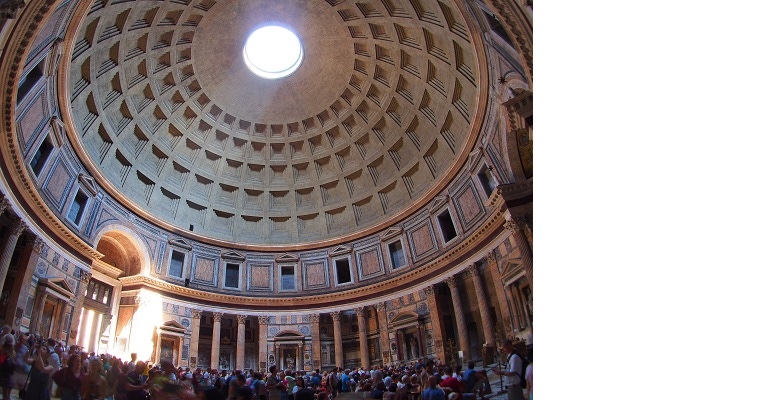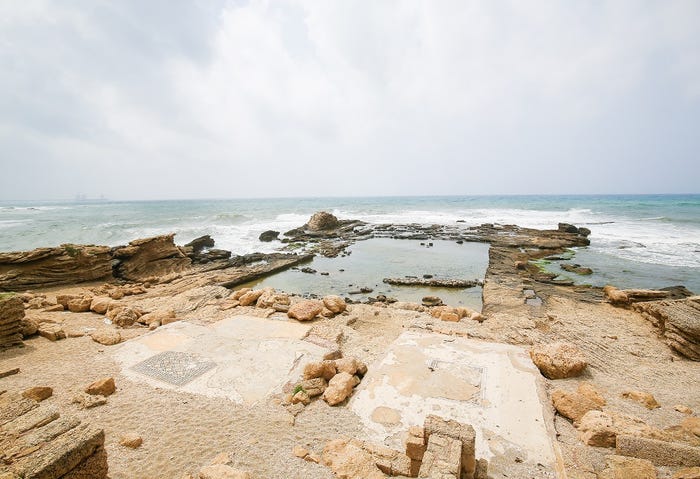In Part Five of this six-part series, concrete historian Luke Snell looks at the accomplishments of the Romans in discovering how to mass produce quality concrete.

When we think of the start of concrete we are immediately drawn to Rome. Some of the concrete structures in Rome have survived for two centuries while our modern concrete structures often show distress in their first 50 years. We are in awe of how they mastered the art of making durable concrete. In this article, we will look at some of the contributions to concrete by Roman engineers and some of the ways they made quality concrete.
By the time of the Roman Empire began (27 BC), the use of lime as a cement was well established. With the Pax Romana (Roman Peace) that lasted for the next 200 years, engineers turned from military activities to civil projects. Thus, began the great development of concrete and a building boom across the Roman empire.
Rome being the center of the Empire attracted many of the outstanding engineers and craftsman of the time. Rome was the place to be, it’s where things were happening. The best wanted to be part of the building boom thus this great talent was able to bring innovation and development of new construction techniques.

Cato
One of the first writers to document this innovation in concrete was Cato in his book De agri cultura (On Farming). He stressed that to make good lime required good quality control and detailed how to accomplish that. He stressed using only good limestone (white and uniform as possible), uniform heat both day and night, along with other procedures. He also provided detailed instruction of how to make a kiln so as to maximize production. Cato followed the same procedures to make lime that were discussed in the Part 4 of this series, with emphasis on improvements that allowed mass production.
Cato recommended a concrete mixture of two parts sand to one part lime. One concrete historian speculates that his quality control standards for making lime was not extended to the sand used to make the mortar or concrete. It appears that he willingly used low grade sand with clay and silt probably because it was cheap or available on his farm.
This resulted in a mixture with high amounts of the more expensive lime. Cato was very frugal, so this is surprising. His contributions to making quality lime should be recognized however and we need to forgive him for not seeing the whole picture of how to make an economical, quality concrete.

Vitruvius
After Cato, much of the development of lime and concrete was documented by Vitruvius in his book De architectura (On Architecture). This book covered many aspects of engineering, architecture, construction, and life in general. Vitruvius started his career in the military but because of the Pax Romana was able to apply his talent to civil projects. Thankfully, he was also a writer and documented the state of engineering and construction. Two of the major developments Vitruvius described that relate to concrete are the use of volcanic ash as a pozzolan and the necessary quality of sand.
Pozzolans
Addition of pozzolans (volcanic ash) to concrete: We now know that pozzolans react with calcium hydroxide and create a cement. Although they didn’t understand the chemistry, they realized that mixing the pozzolans with the lime gave them a better concrete. Vitruvius wrote that “pozzolans mixed with lime and clay bricks cannot only be used in buildings but also for strengthening of structures in the sea, because suddenly it hardens and it can even harden submerged in water.”
This was a major accomplishment. Lime by itself will not set under water (it needs carbon dioxide from the air to set or harden). With the addition of the pozzolans they were able to produce a hydraulic cement that would set under water. It should be noted that not all volcanic ashes react with lime, however the volcanoes near Rome had the right chemistry and made a very durable concrete.
Roman engineers were able to use this technology to build concrete docks and complete harbors; some of this concrete still exists today. It wasn’t until the 20th Century that pozzolan (fly ash) was again used in concrete. Now it is routinely added to most concrete mixtures.

Sand quality
Cato may have had little regard for the quality of the sand he used in his concrete, but Vitruvius took a different approach seeing that good concrete required good quality control of all the materials including the sand.
He wrote that one should not use river or sea sand to make concrete because it is smooth. He recommended using pit sand with its angular edges. We now know that smooth sand will not bond as well with cement and will result in lower concrete strength. The angular sand gives more bonding surfaces for the cement resulting in a stronger concrete.
He also described a test to determine if the sand was acceptable for use. The sand was thrown onto a white cloth. If the sand did not stains the cloth, it would be considered acceptable and could be used in concrete. This test was to determine if organics, silt, or clay were in the sand. We run similar tests today however they are a bit more sophisticated.

Blood
Two other major improvements to concrete that were developed by Roman engineers were the addition of animal blood and the development of lightweight concrete.
No one has a definite idea of why someone thought that adding blood to the concrete was a good thing. Maybe they were looking for ways to dispose of waste blood from the slaughterhouses and someone thought to put it into the concrete. When I was a professor, I would routinely get calls from companies asking if their waste products could be used in concrete. They were not interested in improving concrete, they just wanted to get rid of their waste. This is a possible scenario in Roman times as well.
It was not until the 20th century that we realized that the blood was creating small air voids (entrained air) that protected the concrete from freeze-thaw issues. Today’s concrete still uses this same concept. We add chemicals (admixtures) to concrete to create entrained air to resist freeze-thaw damage; thankfully we no longer use blood.
Although there are many references that the Roman engineers added blood to the concrete, I doubt it was widely done. Too much blood would cause excess entrapped air in the concrete that would weaken the concrete. Thus, the amount of blood would need to be carefully controlled and added to the concrete in small amounts.
Lightweight Concrete
The Pantheon is one of the most remarkable structures to use Roman concrete. To this day, we are unsure how this structure was built, but we do know that part of its success was the use of lightweight concrete in building the dome. A building must be designed to hold all expected loads plus the weight of the building materials (dead load). By using lightweight aggregate, the weight of the concrete is significantly reduced and the engineer has less load to contend with.
Near Rome there was a lot of lightweight aggregate available around the volcanoes. Using these aggregates could reduce the weight of the concrete by up to one-third and allow for a lighter structure with graceful lines and appearance.
I have touched on only a few of the many accomplishments Roman engineers had using concrete. They advanced our knowledge of concrete and became the first to mass produce durable concrete. Unfortunately, with the fall of the Roman Empire (476 AD), much of this concrete technology was lost. For the next 1000 years the basic idea of making and using lime survived with little advancement in concrete. In the 15th century a monk (Giocondo) in Switzerland found in a monastery library the writings of Vitruvius. It makes you wonder how a manuscript found its way from Rome to a monastery in Switzerland and somehow survived for over 1000 years.
Again, by good luck, Giocondo was both a scholar of Latin and engineering, thus he recognized the significance of what he had found. He translated the books of Vitruvius and allowed us to reclaimed the advancements that the Roman engineers had discovered about making concrete.

The next and final article in this series will summarize how concrete got its start.
About the Author(s)
You May Also Like




